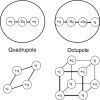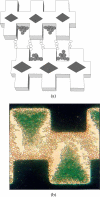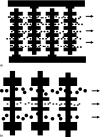Review article-dielectrophoresis: status of the theory, technology, and applications
- PMID: 20697589
- PMCID: PMC2917862
- DOI: 10.1063/1.3456626
Review article-dielectrophoresis: status of the theory, technology, and applications
Abstract
A review is presented of the present status of the theory, the developed technology and the current applications of dielectrophoresis (DEP). Over the past 10 years around 2000 publications have addressed these three aspects, and current trends suggest that the theory and technology have matured sufficiently for most effort to now be directed towards applying DEP to unmet needs in such areas as biosensors, cell therapeutics, drug discovery, medical diagnostics, microfluidics, nanoassembly, and particle filtration. The dipole approximation to describe the DEP force acting on a particle subjected to a nonuniform electric field has evolved to include multipole contributions, the perturbing effects arising from interactions with other cells and boundary surfaces, and the influence of electrical double-layer polarizations that must be considered for nanoparticles. Theoretical modelling of the electric field gradients generated by different electrode designs has also reached an advanced state. Advances in the technology include the development of sophisticated electrode designs, along with the introduction of new materials (e.g., silicone polymers, dry film resist) and methods for fabricating the electrodes and microfluidics of DEP devices (photo and electron beam lithography, laser ablation, thin film techniques, CMOS technology). Around three-quarters of the 300 or so scientific publications now being published each year on DEP are directed towards practical applications, and this is matched with an increasing number of patent applications. A summary of the US patents granted since January 2005 is given, along with an outline of the small number of perceived industrial applications (e.g., mineral separation, micropolishing, manipulation and dispensing of fluid droplets, manipulation and assembly of micro components). The technology has also advanced sufficiently for DEP to be used as a tool to manipulate nanoparticles (e.g., carbon nanotubes, nano wires, gold and metal oxide nanoparticles) for the fabrication of devices and sensors. Most efforts are now being directed towards biomedical applications, such as the spatial manipulation and selective separationenrichment of target cells or bacteria, high-throughput molecular screening, biosensors, immunoassays, and the artificial engineering of three-dimensional cell constructs. DEP is able to manipulate and sort cells without the need for biochemical labels or other bioengineered tags, and without contact to any surfaces. This opens up potentially important applications of DEP as a tool to address an unmet need in stem cell research and therapy.
Figures












Similar articles
-
Methods of Generating Dielectrophoretic Force for Microfluidic Manipulation of Bioparticles.ACS Biomater Sci Eng. 2021 Jun 14;7(6):2043-2063. doi: 10.1021/acsbiomaterials.1c00083. Epub 2021 Apr 19. ACS Biomater Sci Eng. 2021. PMID: 33871975 Free PMC article. Review.
-
Microarray dot electrodes utilizing dielectrophoresis for cell characterization.Sensors (Basel). 2013 Jul 12;13(7):9029-46. doi: 10.3390/s130709029. Sensors (Basel). 2013. PMID: 23857266 Free PMC article.
-
Recent Advances in Dielectrophoretic Manipulation and Separation of Microparticles and Biological Cells.Biosensors (Basel). 2024 Aug 27;14(9):417. doi: 10.3390/bios14090417. Biosensors (Basel). 2024. PMID: 39329792 Free PMC article. Review.
-
Dielectrophoresis Manipulation: Versatile Lateral and Vertical Mechanisms.Biosensors (Basel). 2019 Feb 26;9(1):30. doi: 10.3390/bios9010030. Biosensors (Basel). 2019. PMID: 30813614 Free PMC article. Review.
-
Dielectrophoresis: Developments and applications from 2010 to 2020.Electrophoresis. 2021 Mar;42(5):539-564. doi: 10.1002/elps.202000156. Epub 2020 Dec 28. Electrophoresis. 2021. PMID: 33191521 Free PMC article. Review.
Cited by
-
Directed Assembly of Nanomaterials for Making Nanoscale Devices and Structures: Mechanisms and Applications.ACS Nano. 2022 Nov 22;16(11):17641-17686. doi: 10.1021/acsnano.2c07910. Epub 2022 Oct 21. ACS Nano. 2022. PMID: 36269234 Free PMC article. Review.
-
Microfluidic impedance cytometry of tumour cells in blood.Biomicrofluidics. 2014 Dec 12;8(6):064124. doi: 10.1063/1.4904405. eCollection 2014 Nov. Biomicrofluidics. 2014. PMID: 25553198 Free PMC article.
-
Electrokinetic stacking of particle zones in confined channels enabling their UV absorbance detection on microchips.Anal Chim Acta. 2020 Oct 23;1135:83-90. doi: 10.1016/j.aca.2020.08.019. Epub 2020 Aug 22. Anal Chim Acta. 2020. PMID: 33070862 Free PMC article.
-
Dielectrophoretic characterization of peroxidized retinal pigment epithelial cells as a model of age-related macular degeneration.BMC Ophthalmol. 2024 Aug 13;24(1):340. doi: 10.1186/s12886-024-03617-0. BMC Ophthalmol. 2024. PMID: 39138426 Free PMC article.
-
An insulator-based dielectrophoretic microdevice for the simultaneous filtration and focusing of biological cells.Biomicrofluidics. 2011 Dec;5(4):44105-4410511. doi: 10.1063/1.3658644. Epub 2011 Oct 31. Biomicrofluidics. 2011. PMID: 22662057 Free PMC article.
References
-
- Pohl H. A., J. Appl. Phys. JAPIAU 22, 869 (1951).10.1063/1.1700065 - DOI
-
- Mottelay P. F., Bibliographical History of Electricity and Magnetism (Charles Griffin, London, 1922).
-
- Abraham M., The Classical Theory of Electricity and Magnetism (English Translation of 8th German Edition) (Hafner, New York, 1932).
-
- Hatfield H. S., Trans. Inst. Min. Metall. 33, 335 (1924).
-
- Pohl H. A., Dielectrophoresis (Cambridge University Press, Cambridge, 1978).
LinkOut - more resources
Full Text Sources
Other Literature Sources
Miscellaneous
